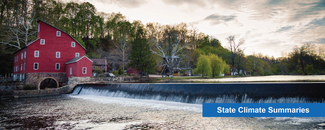Local perspective emphasized in individual U.S. state summaries

New climate summaries from NOAA offer up-to-date, local perspectives on climate in each state, covering the entire United States plus Puerto Rico and the U.S. Virgin Islands. The new State Climate Summaries have been developed in partnership with the Cooperative Institute for Satellite Earth System Studies (CISESS), six Regional Climate Centers (RCCs), and individual state climatologists. An interactive website hosted by CISESS gives the public easy access to the information.
The State Climate Summaries spell out recent local conditions for each state and provide insights about the state’s climate outlook based on historical trends. Climate is distinguished from daily weather because climate reflects a longer period of time and measures averages of weather conditions. The summaries, which are available both as web pages and downloadable PDFs ranging from four to six pages in length, describe historical temperature and precipitation conditions for each state and use several visual aids to show past observations and plausible future projections.
Specifically, the summaries cover:
- Historical climate variations and trends
- Noteworthy extreme weather events
- Future projections of climate conditions over the next century
- Past and future conditions of sea level and coastal flooding, where applicable
The summaries and graphics are an outgrowth of an ongoing effort by NOAA and partners, including the U.S. Global Change Research Program (USGCRP), to share easily understood information with the public about the state of the climate in the United States. The effort supports individuals, organizations, tribes, and communities in building their understanding of climate conditions and demonstrating the importance and significance of changes occurring locally, nationwide, and ultimately, globally.
State Climate Summaries: Showing and Telling
For each state, a summary is paired with three concise “Key Messages” that briefly describe specific conditions that are unique to the individual state’s climate. Key Messages highlight temperature and precipitation information and include regionally important details, such as issues pertaining to coastal flooding, drought risks, agricultural impacts, and snowpack, among other conditions.
Accompanying each longer summary are simple graphics—figures such as bar charts, line graphs, and maps—to show trends and make the information more easily understandable. Each summary includes a standard set of figures, beginning with the state’s Observed and Projected Temperature Change. The temperature change graphic shows possible increases in each state based on two possible futures, also referred to as pathways: one in which greenhouse gas emissions continue to increase rapidly (higher emissions) and another in which greenhouse gas emissions increase at a slower rate (lower emissions). Greenhouse gas emissions, primarily due to human activity, are the main driver of global climate change.
Additional figures are provided for unique climate-related conditions that are relevant to a state, such as information about the levels of important bodies of water or the intensity of drought based on the Palmer Drought Severity Index.
From the State Climate Summaries website, all 51 summaries can be downloaded as PDFs or accessed online, as can each individual figure. Figures are clickable to enlarge on any screen and can be shared via social media and email.
Data Supporting the State Climate Summaries
The scientific data used to build each summary chiefly come from the authoritative signature datasets stewarded by NOAA NCEI. Those specifically include:
- GHCNd, Global Historical Climatological Network-Daily, daily climate records
- nClimDiv, Climate Divisional Dataset, several weather indices for 344 climate divisions
Additional data are used from widely available sources, such as the Fourth National Climate Assessment (NCA4). A robust review process included regional partners and individual state climatologists. The summaries are also supported by the White House Office of Science and Technology Policy.
A key feature of this project is the extensive metadata that is provided for each of the more than 500 figures. Metadata is critical for transparency and reproducibility of the information and findings presented in figures. It provides users access to data, methods, and, for the first time ever, source code, allowing users to reproduce results or do their own original analysis. Documentation meets the highest standards under the Information Quality and Foundations for Evidence-Based Policymaking Acts. Documentation for each figure is available through the metadata viewer, which can be accessed by clicking the eyeball icon appearing with each figure in the summaries. See this example for Delaware. Additional information about data and methods is provided in a Technical Details document.
A growing recognition of the need for local state-centric climate information arose after the passage of the U.S. Global Change Research Act of 1990, which led to the production of the National Climate Assessment. A first set of state summaries was released in 2017 ahead of the issuance of NCA4. NCA5 is scheduled for release in 2023.
Reference: Kunkel, K. E., R. Frankson, J. Runkle, S. M. Champion, L. E. Stevens, D. R. Easterling, B. C. Stewart, A. McCarrick, and C. R. Lemery (Eds.), 2022: State Climate Summaries for the United States 2022. NOAA Technical Report NESDIS 150. NOAA/NESDIS, Silver Spring, MD.






